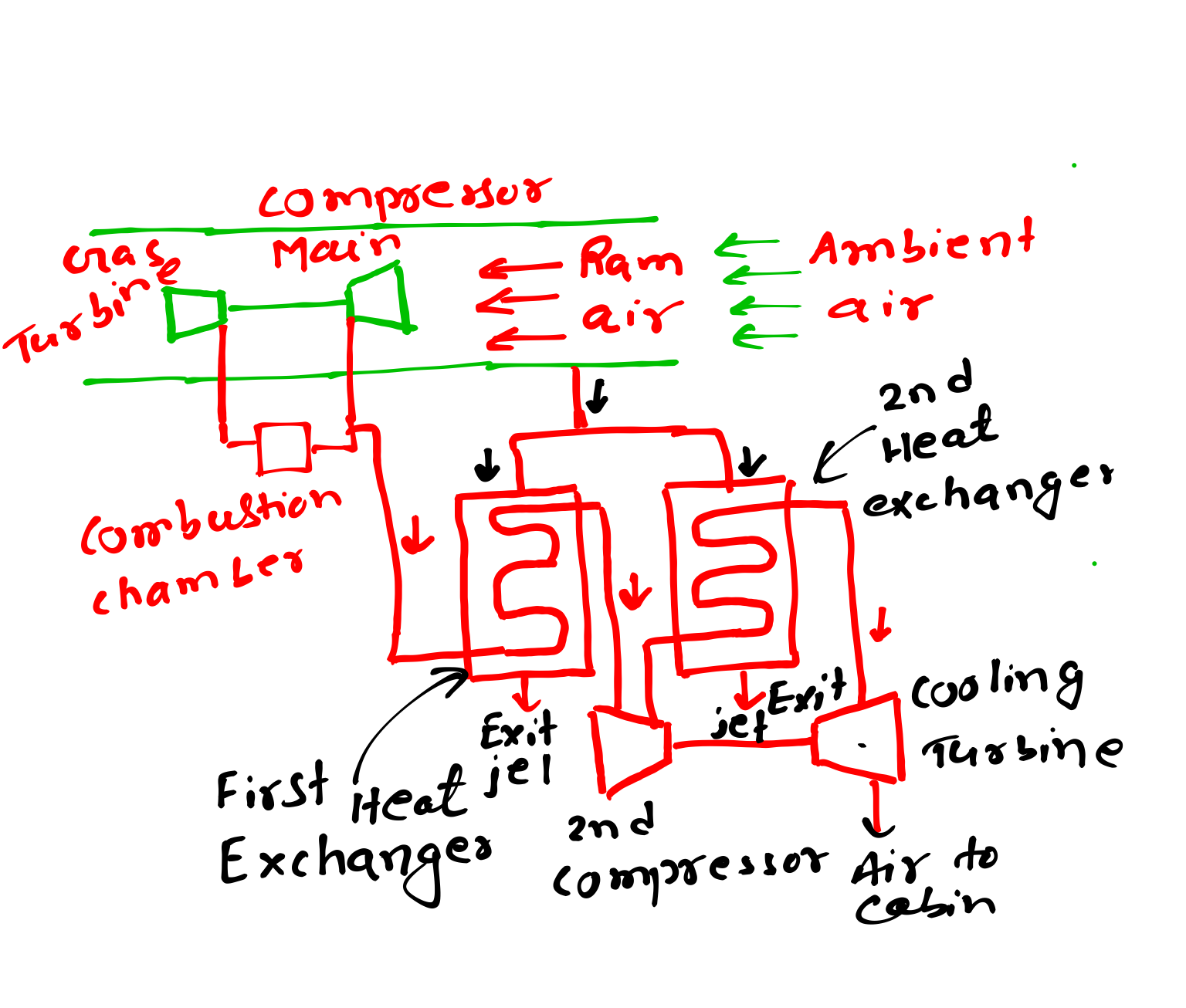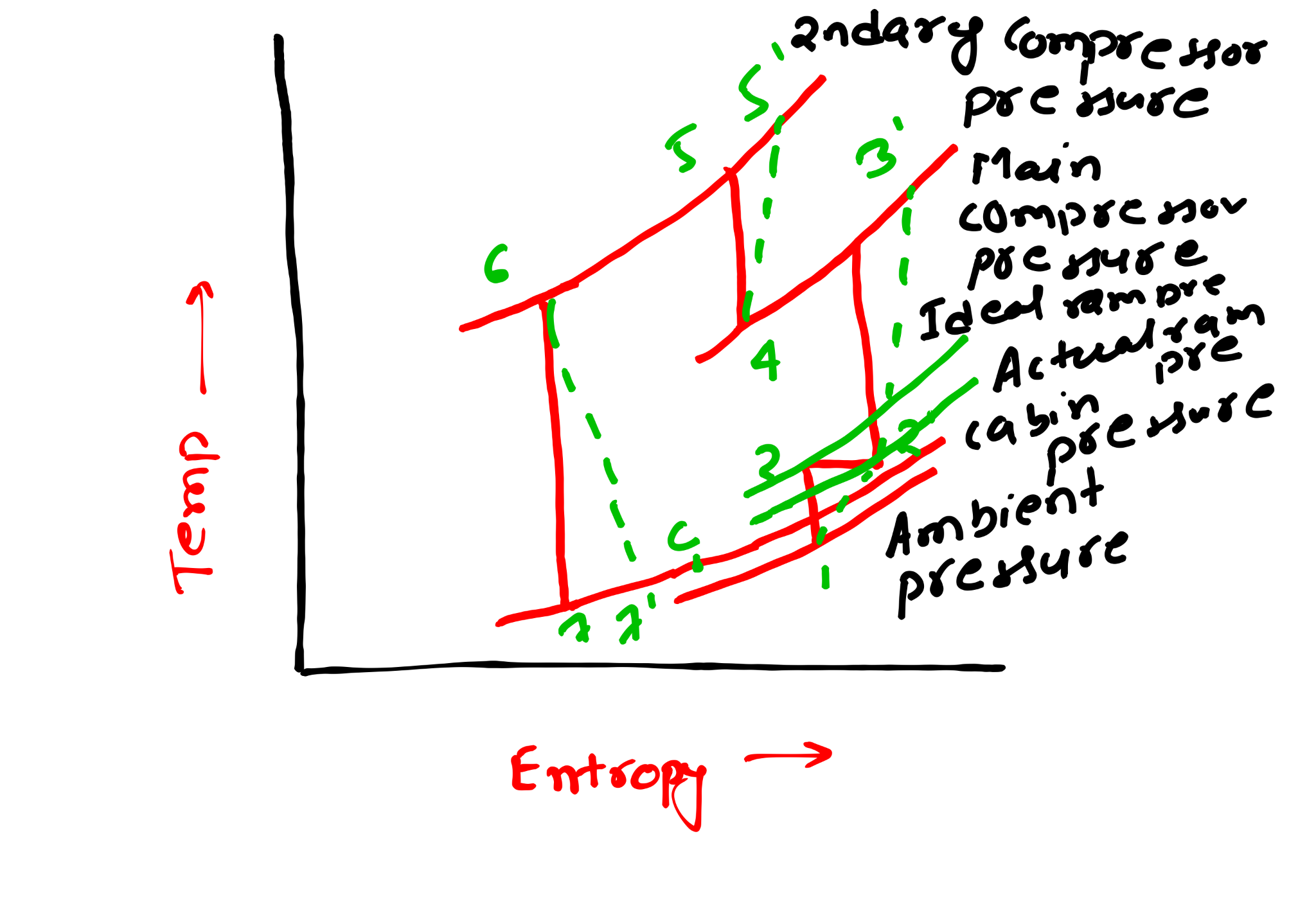In this article, you will learn about bootstrap air cooling refrigeration system, explanation, working with MCQ’s with solution, in the last article I talk about simple aircraft refrigeration system.
What is Boot Strap Air Cooling Refrigeration?
This is one of the type of refrigeration system which is used in aircraft, well there are many types of refrigeration system used in aircraft. But this type of refrigeration system mostly used in transport aircraft. This refrigeration system is not used for ground cooling.
Working of Boot Strap Air Cooling Refrigeration-
This air cooling system has two heat exchangers but in case of simple air cooling system having only one heat exchanger.
Cooling turbine is running secondary compressor which we can see in the below diagram as well.
In this case air cooled two times once it is cooled by ram air by first heat exchanger and in the second time same cooled air compressed by secondary compressor then cooled by second heat exchanger.
Diagram of Boot Strap Air Cooling Refrigeration-

TS Diagram of Boot Strap Air Cooling Refrigeration-

Formula of Boot Strap Air Cooling Refrigeration-
Here we will learn three formula those are required to solve numerical problem related to it.
Mass of air required for refrigeration purpose-
Ma = 210q/Cp(Tc – Tt)
q- ton of refrigeration which is the cooling load of the turbine
Tc- Cabin temperature
Tt- Cooling turbine temperature
Power needed for refrigeration-
P = MaCp(T3i – T2i)/60 kW
COP = 210q/MaCp(T3i – T2i)
Key Points About Boot Strap Refrigeration-
- Bootstrap air cooling refrigeration system pre-cools the primary refrigerant with a secondary loop, enhancing efficiency.
- Secondary refrigerant cools the main refrigerant in a heat exchanger before entering the compressor.
- Increased cooling capacity and improved COP with reduced compressor workload.
- Water commonly used as the environmentally friendly secondary refrigerant.
- Ideal for air conditioning and space cooling applications with compact design.
- Reduces system size and complexity compared to traditional air cooling systems.
- Potential for cascade systems for even greater cooling performance.
Important MCQ’s of Boot Strap Air Cooling Refrigeration-
MCQ 1: What is the primary purpose of a bootstrap refrigeration system?
a) To reduce the size of the evaporator
b) To improve the efficiency of the compressor
c) To use a secondary refrigerant loop for enhanced cooling
d) To eliminate the need for a condenser in the refrigeration cycle
Explanation: The correct answer is c.
A bootstrap refrigeration system utilizes a secondary refrigerant loop to enhance the cooling capacity and improve the overall efficiency of the refrigeration cycle.
MCQ 2: Which component in a bootstrap refrigeration system is responsible for transferring heat from the primary refrigeration loop to the secondary loop?
a) Evaporator
b) Compressor
c) Heat exchanger
d) Condenser
Explanation: The correct answer is c.
The heat exchanger is the component responsible for transferring heat from the primary refrigeration loop to the secondary loop in a bootstrap refrigeration system.
MCQ 3: What is the function of the secondary refrigerant in a bootstrap refrigeration system?
a) To provide cooling to the evaporator
b) To provide cooling to the compressor
c) To cool the condenser
d) To pre-cool the primary refrigerant before entering the compressor
Explanation: The correct answer is d.
The secondary refrigerant in a bootstrap refrigeration system pre-cools the primary refrigerant before it enters the compressor, increasing system efficiency.
MCQ 4: Which refrigerant is commonly used as the secondary refrigerant in a bootstrap refrigeration system?
a) R134a
b) Ammonia (NH3)
c) Carbon dioxide (CO2)
d) Water (H2O)
Explanation: The correct answer is d.
Water is commonly used as the secondary refrigerant in a bootstrap refrigeration system due to its availability and favorable thermodynamic properties.
MCQ 5: What advantage does a bootstrap refrigeration system offer compared to traditional refrigeration systems?
a) Lower initial cost
b) Higher cooling capacity
c) Reduced energy consumption
d) Simplicity of design
Explanation: The correct answer is c.
A bootstrap refrigeration system can reduce energy consumption and improve overall efficiency by using the secondary loop to pre-cool the primary refrigerant.
MCQ 6: In a bootstrap refrigeration system, the primary and secondary refrigeration loops are connected through:
a) A compressor
b) A condenser
c) An evaporator
d) A heat exchanger
Explanation: The correct answer is d.
The primary and secondary refrigeration loops in a bootstrap system are connected through a heat exchanger, allowing heat transfer between the two loops.
MCQ 7: What is the primary advantage of using carbon dioxide (CO2) as the secondary refrigerant in a bootstrap refrigeration system?
a) Environmentally friendly
b) High cooling capacity
c) Low cost
d) Readily available
Explanation: The correct answer is a.
Using carbon dioxide (CO2) as the secondary refrigerant in a bootstrap system provides an environmentally friendly refrigeration solution.
MCQ 8: Which component of a bootstrap refrigeration system controls the flow rate of the primary refrigerant?
a) Compressor
b) Condenser
c) Expansion valve
d) Heat exchanger
Explanation: The correct answer is c.
The expansion valve controls the flow rate of the primary refrigerant in a bootstrap refrigeration system.
MCQ 9: In a bootstrap refrigeration system, the secondary refrigerant is pumped by:
a) The compressor of the primary loop
b) An independent pump
c) The condenser of the primary loop
d) A throttling device
Explanation: The correct answer is b.
The secondary refrigerant is pumped by an independent pump in a bootstrap refrigeration system to ensure proper flow in the secondary loop.
MCQ 10: What is a potential drawback of a bootstrap refrigeration system?
a) Reduced cooling capacity
b) Increased maintenance requirements
c) Higher initial cost
d) Incompatibility with common refrigerants
Explanation: The correct answer is c.
One potential drawback of a bootstrap refrigeration system is the higher initial cost due to the addition of a secondary loop and a heat exchanger.
MCQ 11: How does a bootstrap refrigeration system achieve improved efficiency?
a) By using a larger compressor in the primary loop
b) By reducing the flow rate of the secondary refrigerant
c) By using a smaller condenser in the secondary loop
d) By utilizing the pre-cooling effect of the secondary loop
Explanation: The correct answer is d.
A bootstrap refrigeration system achieves improved efficiency by utilizing the pre-cooling effect of the secondary loop to reduce the workload on the main compressor.
MCQ 12: Which component of a bootstrap refrigeration system ensures that the secondary refrigerant returns to its liquid state after absorbing heat from the primary loop?
a) Evaporator
b) Compressor
c) Heat exchanger
d) Condenser
Explanation: The correct answer is a.
The evaporator in the secondary loop absorbs heat from the primary refrigeration loop, causing the secondary refrigerant to change from vapor to liquid state.
MCQ 13: Why is it essential to choose the appropriate secondary refrigerant for a bootstrap refrigeration system?
a) To prevent damage to the heat exchanger
b) To ensure compatibility with the primary refrigerant
c) To reduce the risk of compressor failure
d) To minimize energy consumption
Explanation: The correct answer is b.
Choosing the appropriate secondary refrigerant is important to ensure compatibility with the primary refrigerant and overall system performance.
MCQ 14: In a bootstrap refrigeration system, which component removes heat from the secondary refrigerant before it enters the heat exchanger?
a) Compressor
b) Condenser
c) Expansion valve
d) Evaporator
Explanation: The correct answer is d.
The evaporator removes heat from the secondary refrigerant, causing it to absorb heat from the primary loop in the heat exchanger.
MCQ 15: The primary purpose of the heat exchanger in a bootstrap refrigeration system is to:
a) Increase the pressure of the secondary refrigerant
b) Transfer heat between the primary and secondary loops
c) Control the flow rate of the primary refrigerant
d) Regulate the temperature of the secondary refrigerant
Explanation: The correct answer is b.
The heat exchanger facilitates the transfer of heat between the primary and secondary loops in a bootstrap refrigeration system.
MCQ 16: Which of the following statements about the energy efficiency of a bootstrap refrigeration system is true?
a) It is always higher than traditional refrigeration systems
b) It is always lower than traditional refrigeration systems
c) It depends on the ambient temperature
d) It is not affected by the choice of secondary refrigerant
Explanation: The correct answer is c.
The energy efficiency of a bootstrap refrigeration system can be affected by the ambient temperature, just like any other refrigeration system.
MCQ 17: In a bootstrap refrigeration system, the secondary refrigerant enters the heat exchanger as:
a) A liquid and exits as a liquid
b) A vapor and exits as a vapor
c) A liquid and exits as a vapor
d) A vapor and exits as a liquid
Explanation: The correct answer is c.
The secondary refrigerant enters the heat exchanger as a liquid and exits as a vapor after absorbing heat from the primary loop.
MCQ 18: Which of the following is a potential application for a bootstrap refrigeration system?
a) Residential air conditioning
b) Spacecraft thermal management
c) Automotive engine cooling
d) Water desalination
Explanation: The correct answer is b.
A bootstrap refrigeration system can find potential applications in spacecraft thermal management, where efficiency and compactness are crucial.
MCQ 19: How does a bootstrap refrigeration system improve energy efficiency?
a) By reducing the size of the compressor
b) By eliminating the need for an evaporator
c) By pre-cooling the primary refrigerant using a secondary loop
d) By using a larger condenser in the refrigeration cycle
Explanation: The correct answer is c.
A bootstrap refrigeration system improves energy efficiency by pre-cooling the primary refrigerant using a secondary loop, which reduces the compressor workload.
MCQ 20: What role does the expansion valve play in a bootstrap refrigeration system?
a) To control the flow rate of the secondary refrigerant
b) To control the flow rate of the primary refrigerant
c) To regulate the pressure in the secondary refrigerant loop
d) To regulate the pressure in the primary refrigerant loop
Explanation: The correct answer is b.
The expansion valve in a bootstrap refrigeration system controls the flow rate of the primary refrigerant, allowing for efficient cooling in the evaporator.